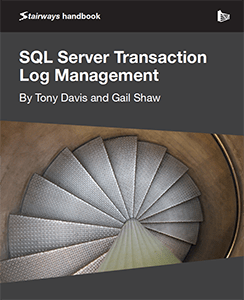Efficiently Polling Remote Data Sources
In this article, Edward Pollack describes some of the issues when querying against remote data sources. He covers remote SQL Servers and also connecting to a PostgreSQL database.
Better SQL Server Agent Job Failure Monitoring
SQL Server Agent has a built-in alerting process for when jobs fail, but the information it provides isn’t very useful. You’re only told which job, what time, who ran it, and which step failed. If you want to see why it failed, you have to review the job history manually. On a busy system with […]
Building Quality In
I heard someone at the 2020 DevOps Enterprise Summit conference say that quality needs to be built in. That's something that many, or hopefully most, of us believe. Everyone ought to do quality work and build it into their daily tasks. However, the person speaking went further and defined this in a way I like: […]
Adding Custom Stored Procedure Templates to SQL Server Management Studio and Visual Studio 2019
In this article we look at how to build a custom stored procedure template that can be used in either SSMS or Visual Studio for all new development.
Create a Feedback Loop between Devs and DBA Teams with Monitoring
With remote working still encouraged around the world, there is a need to ensure that operations teams have full visibility of your estate, not just your production servers. If your engineering teams have access to secure development and testing servers, deployment issues are caught before they reach production. Find out how to keep communication flowing between DBA and development teams in this free whitepaper. Read the whitepaper here.
Free eBook: SQL Server Transaction Log Management
When a SQL Server database is operating smoothly and performing well, there is no need to be particularly aware of the transaction log, beyond ensuring that every database has an appropriate backup regime and restore plan in place. When things go wrong, however, a DBA's reputation depends on a deeper understanding of the transaction log, both what it does, and how it works.
Blogs
Modify Power BI page visibility and active status with Semantic Link Labs
Setting page visibility and the active page are often overlooked last steps when publishing...
T-SQL Tuesday #190–Mastering a New Technical Skill
By Steve Jones
It’s time for T-SQL Tuesday again and this time Todd Kleinhans has a great...
Getting Started with the MSSQL AI Agent in VS Code
By Steve Jones
Recently I was working in VS Code and I saw a walkthrough for the...
Forums
Password Guidance
Comments posted to this topic are about the item Password Guidance
Using table variables in T-SQL
Comments posted to this topic are about the item Using table variables in T-SQL
Azure elastic query credential question
I am trying to check out elastic query between two test instances we have...
Question of the Day
Using table variables in T-SQL
What happens if you run the following code in SQL Server 2022+?
declare @t1 table (id int); insert into @t1 (id) values (NULL), (1), (2), (3); select count(*) from @t1 where @t1.id is distinct from NULL;See possible answers






